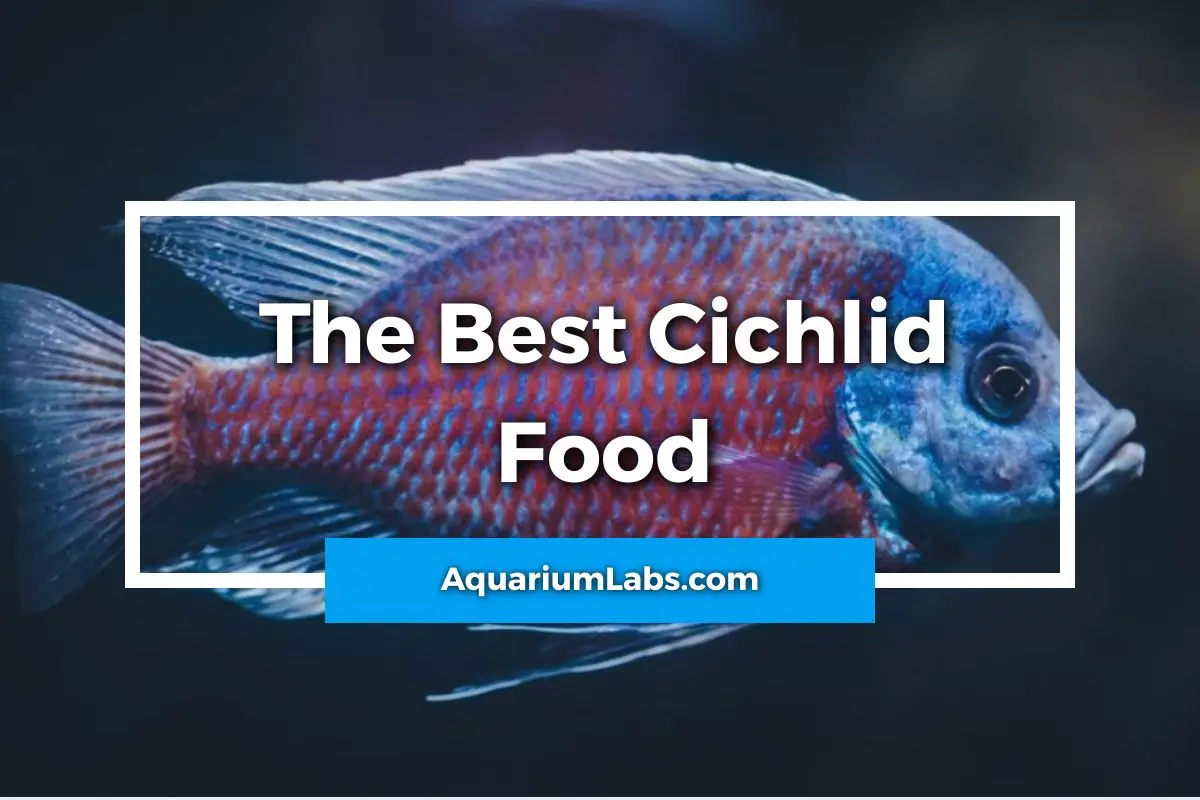Feeding our fish is one of the highlights of the aquarium hobby! And cichlids, with their active dispositions and eager table manners, are worth offering the very best products to.
These days it’s a crowded market full of excellent pellet, flake, crisp, and stick formulas to look at. And things get further complicated when we consider whether we have fish that eat only meat, only plants, or both…
So let’s take a moment to consider the best cichlid foods on the market right now. And then we’ll break down what cichlids eat and how to provide the best nutrition for them!
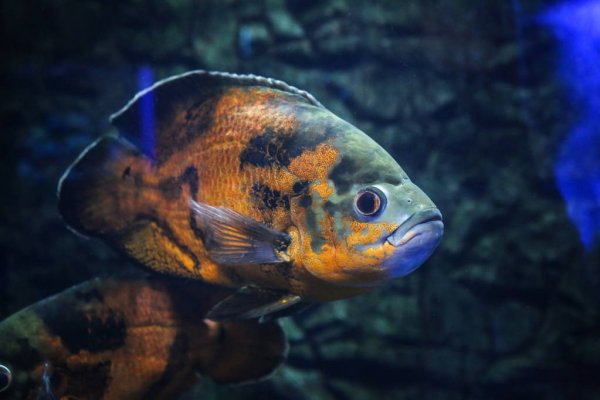
The Top Cichlid Foods of 2025
- Fluval Bug Bites
- Hikari Cichlid Gold
- Tetra Cichlid Cichlid Crisps
- Northfin Food Cichlid Formula
- Omega One Super Color Sinking Pellets
- Northfin Food Veggie Formula
- Aqueon Cichlid Food Pellets
- TetraCichlid Floating Cichlid Pellets
- New Life Spectrum Cichlid Formula
- Omega One Veggie Rounds
- TetraCichlid Floating Sticks
What Do Cichlids Normally Eat?
Herbivorous Cichlids
Many cichlids are herbivorous fish. As herbivores, they eat primarily aquatic plants and algae, which are rich in essential vitamins. Saltwater fish find ocean kelp palatable for the same reason – and seaweed, nori, and other sea vegetables are an excellent source of food for herbivorous cichlids!

You can often identify an herbivore if it has flat, scraping teeth and a downturned mouth used to pick at plants and hard surfaces. Examples of herbivorous species include Tilapia, Malawi cichlids like the Mbuna (rock algae grazers), and the Lake Tanganyikan Tropheus genus.
Carnivorous Cichlids
Carnivorous fish, on the other hand, have evolved to hunt down other animals for food. Many are mid-water-feeding cichlids since they need to be constantly on the lookout for smaller prey. They often have lean, powerful bodies built for sudden bursts of speed and wide mouths filled with sharp teeth.
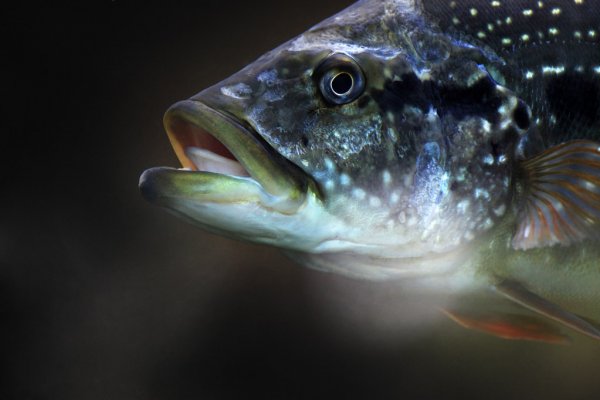
Since they feed primarily on animals, carnivores need higher amounts of protein in the fish’s diet than herbivores do. Well-known carnivorous cichlids include Oscars, Jaguar Cichlids, and Peacock Bass!
Omnivorous Cichlids
Omnivorous cichlids are very common, both in the aquarium hobby and in the wild. They will eat a little bit of everything to satisfy their appetites. Worms, plants, other fish, algae, insects…A varied diet is what they thrive on, just like us humans!

Omnivores are also variable in how they look, so they can be harder to identify at times. But a few common examples include Peacock cichlids (Aulonocara sp.) and Electric Yellow Labidichromis!
Selecting the Best Fish Food for Optimal Cichlid Growth, Color, and Health
What Sources of Nutrients are Best for Cichlids?
Something I always recommend doing is getting used to reading the nutritional labels on fish food. As with human food, manufacturers have to list what goes into a prepared cichlid formula.
The best food for cichlids comes from ingredients that are close to what they would find in nature. For example, protein sources are especially important to understand. Lower quality fish food blends sometimes skip them entirely, use tiny amounts of fish, or use inferior protein sources like soybean. While soybeans are rich in protein, plant protein is a poor substitute for the insects, worms, and fish that the bodies of omnivorous and carnivorous fish expect.
Protein is used for muscle building and repair and is a structural component for most major bodily systems. Even vegetarian fish need protein for the above reasons, though they can make better use of plant-based sources than others.
Nutrient sources matter. That said, there are several more essential nutrients to look out for when shopping for a good cichlid formula!

Other Important Nutrients for Cichlids
Carbohydrates
Besides protein and fat, carbohydrates are one of the three most commonly found organic molecules in both human and fish food! However, it is far less useful for fish than it is for us because aquatic plants have very little of it compared to terrestrial sources like grains, fruit, and tubers.
As a result, fish have very little use for carbohydrates. In fact, according to this study by Virginia State University, fish can only extract 1.6 calories of energy per gram of carbs, compared to 4 calories per gram for mammals.
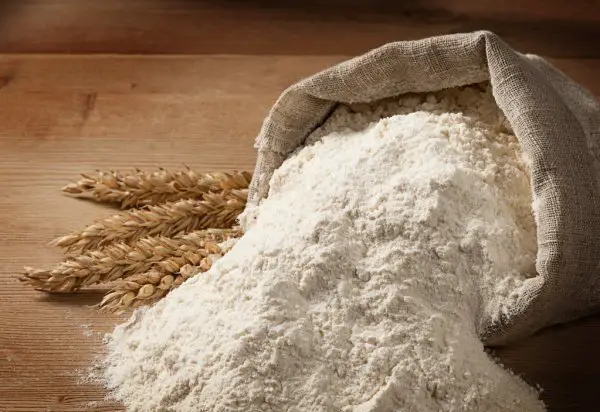
This can be a problem when hunting for the best cichlid food because so much fish food out there is loaded with potato starch, wheat starch, soybean meal, wheat flour, and other cheap fillers to bulk up the product. If your cichlids are herbivores, this is less of an issue; herbivorous fish are better at digesting starch than carnivores. Bur for predators, you should be looking out for cichlid foods with protein-rich base ingredients like herring meal, salmon fish meal, brine shrimp, and other animal sources.
Omega 3 & Omega 6
Whole salmon and other fish are famous for being a source of food rich in omega-3 and omega-6 fatty acids. But the majority of fish don’t actually create these inflammation-reducing, heart and brain-healthy molecules themselves. They concentrate it on their prey. Natural sources of food rich in these agents include crustaceans, plankton, and algae. All of which are good cichlid food!
Study the ingredients label carefully to identify natural sources of Omega-3 and Omega-6, including whole Antarctic krill meal and spirulina algae.
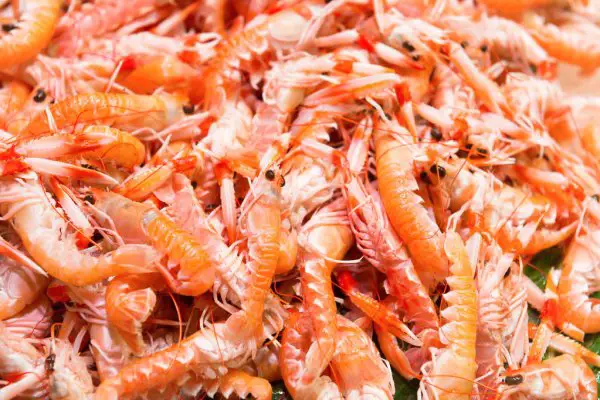
Insoluble Fiber
Insoluble fiber is and is not a “nutrient” for animals, including cichlids. Insoluble fiber is often thought of as the “bulk” portion of a balanced diet. Since most animals cannot digest it, it provides roughage and helps move gut contents along, from the stomach to the intestines to expulsion as feces.
Omnivores and herbivores need insoluble fiber much more than carnivores do, with their shortened intestinal tract. Fish foods with insoluble fiber also ensure that digestion doesn’t happen too quickly, and food stays in the gut long enough for all of the nutrients to be extracted.
Pigments & Color Enhancing Agents
Pigments and color-enhancing agents aren’t nutrients in the classical sense; healthy cichlids don’t really require them. But they do ensure that you can fully appreciate their natural bright colors!
This is because many of the molecules fish use to show off to each other are borrowed from the species’ preferred food source. For example, feeding cichlids a diet rich in Antarctic krill and other sources rich in astaxanthin will promote more vibrant reds in your fish.
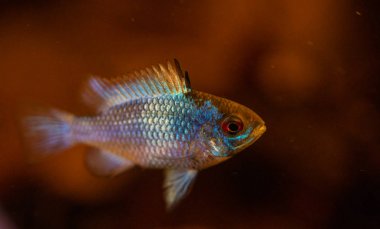
Yellow pigments come from lutein and zeaxanthin, also found in crustaceans underwater. But also in terrestrial foods like carrots, turmeric, and egg yolk.
Color-enhancing fish food uses natural and artificial sources of these pigments that are incorporated into the cichlid’s bodies when fed to them!
Salt Levels
Salt is important for freshwater fish and serves several functions in the body, including ion regulation and immune system health. Exactly how important the salt content in cichlid food remains controversial. Some studies suggest that elevated salt levels can slightly boost growth, while others say otherwise.
Since salt is rarely listed as an ingredient in most cichlid food formulas, I wouldn’t pay too much attention to it. Most fish obtain all of the salt they need from their environment, even freshwater fish.
And many fish, including African cichlids, come from bodies of water rich in dissolved salts, such as the African Rift Lakes. So providing trace amounts of salt in the water of your fish tank will do more to keep your cichlids healthy than finding food with trace amounts.
Providing a Varied Diet for Cichlid Health

One of the best ways to keep fish healthy is to provide them with a wide variety of high-quality fish food. We don’t want to rely on just one formula to feed cichlids, no matter how healthy they may be. A balanced diet will include a few good prepared formulas mixed with helpings of live, frozen, and fresh foods! In this way, we can cover the nutritional gaps missed by any one cichlid food.
A good food sampling for an omnivorous cichlid tank might include high-quality carnivore floating pellets, organic kelp, brine shrimp, green peas, and a vegetarian fish food rich in algae meal!
The 11 Best Cichlid Foods of 2025
Now that we’ve covered what nutrients are essential to a balanced diet, we should look at the best cichlid fish food on the market right now!
#1. Fluval Bug Bites Cichlid Formula for Small/Medium Fish, 1.59-Ounces

The best food sources always include products that are identical to what cichlids would find in nature. Fluval Bug Bites is one of the best cichlid food sources because the main ingredient is black soldier fly larvae, farmed insects that are rich in protein. While Fluval Bug Bites come in various sizes, they are all slow sinking pellets that ensure fish in all regions of the tank can enjoy them.
And to better balance their formula for omnivores, Fluval includes a whole salmon meal for a dose of Omega-3 and Omega-6 fatty acids and fish protein concentrate before adding pea protein and other vegetarian sources.
Ingredients List: Dried Black Soldier Fly larvae, Salmon, Fish Protein Concentrate, Green Peas, L-lysine, Vitamin E supplement, Biotin, Niacin (Vitamin B), Vitamin B12 supplement, Beta-carotene, Rosemary Extract, Riboflavin, Vitamin A supplement
Pros:
- Main ingredient is insect larvae, a natural food source for fish
- First three ingredients are all high-quality animal protein sources
- Highly palatable to most cichlids
- Low in carbohydrates
Cons:
- Consistency is fairly hard and takes time to soften
#2. Hikari Cichlid Gold Floating Pellets, 8.8 oz

Hikari Cichlid Gold Floating Pellets are a staple formula in the hobby for aquarists with medium to large-sized cichlids. Whole fish meal (typically herring meal) is the number one ingredient, providing quality protein for cichlids that need animal matter in their diet.
Garlic extract acts as a smell and taste stimulant, which improves its palatability for picky eaters. Spirulina provides fatty acids and stabilized vitamin C, vitamin A, and vitamin D further balance the nutritional profile. And true to its name, the astaxanthin content brightens gold, red, and yellow colors in your fish.
Ingredients List: Fish meal, Wheat Flour, Flaked Corn, Brewers Dried Yeast, Spirulina, Garlic, Stabilized Vitamin C, Astaxanthin, Vitamin A supplement, Niacin, Folic Acid, Vitamin D3 supplement, Biotin
Pros:
- Astaxanthin for color enhancement
- Garlic extract to stimulate appetite and boost immune system health
- Stabilized vitamin C, A, and D
Cons:
- Ingredients list includes many processed vegetarian sources of food
#3. TetraCichlid Cichlid Crisps

Tetra is a name brand for aquarists for very good reason, and their Cichlid Crisps are one of the best cichlid food sources for diverse sources of protein. Fish meal, yeast, shrimp, wheat gluten, and soybean meal provide a balanced variety of plant and animal-based sources. And the vitamin additives further enhance the nutrient profile!
Ingredients List: Fish Meal, Fish Oil, Dried Yeast, Shrimp Meal, Wheat Gluten, Dehulled Soybean Meal, Algae Meal, Ascorbic Acid (Vitamin C), Niacin, Vitamin E, Vitamin B12, Canthaxanthin
Pros:
- Wide variety of plant and animal-sourced proteins
- Enhanced profile of additional vitamins
- Formulated to be more digestible, creating up to 35% less waste
- Crisp formula floats longer compared to flakes
Cons:
- Fewer whole ingredients compared to other blends
#4. Northfin Food Cichlid Formula

Northfin Cichlid Food is popular because it uses no fillers, artificial pigments, or hormones. Just whole animal and plant products, making it the cichlid food of choice for health-conscious aquarists.
These are small sinking pellets 2mm in diameter that are perfectly sized for medium-sized fish. A larger 3mm pellet is also available, and both are fully loaded with a complete spectrum of animal and plant-based nutrient souces.
Ingredients List: Whole Antarctic Krill Meal, High Omega-3 DHA Herring Meal, Whole Sardine Meal, Wheat Flour, Organic Kelp, Spirulina, Garlic, Astaxanthin, Montmorillonite Clay (rich in Calcium), Vitamin A Acetate, Vitamin B12, Niacin
Pros:
- Slow sinking pellets ensure little goes to waste
- Diverse spread of fish, crustacean, kelp, and algae-based nutrition
- Fortified with garlic extract, vitamins, and pigment enhancers
Cons:
- Pricier since it uses premium ingredients
#5. Omega One Super Color Sinking Pellets

A balanced cichlid fish food contains a broad spectrum of ingredients to appeal to omnivorous palates, as Omega One has done. Coupled with several pigment boosters, the orange, red, and yellow tones in your fish will be more vibrant than before.
Another aspect of this cichlid food that caught my attention is the reduced use of powders and meals. Many ingredients lose some of their nutritional content when dried and powdered, which accelerates oxidizing.
Ingredients List: Salmon, Whole Herring, Wheat Germ, Whole Shrimp, Pea Protein, Kelp, Astaxanthin, Canthaxanthin, Marigold Extract, Natural and Artificial Colors, Vitamin C, Niacin, Vitamin A, Vitamin D3, Vitamin E, Vitamin B12
Pros:
- Uses fewer powder and meal-based additives, which are less nutritious than whole ingredients
- Ash and fiber content of 10%, ensuring that 90%+ of the material is fully digestible
- Great cichlid food for color enhancement
Cons:
- Fewer whole plant ingredients, making it less suitable for herbivores
#6. Northfin Food Veggie Formula

The vegetarian Northfin cichlid food blend uses fewer but higher quality ingredients for cichlid fish health, like their omnivore formula. Kelp is the number one ingredient, balanced by spirulina, garlic, and a bit of animal protein to give vegetarians a protein boost.
This plant-based formula is the best cichlid food for African cichlids, many of which are primarily herbivorous!
Ingredients List: Kelp, Antarctic Krill Meal, High Omega-3 (DHA) Herring Meal, Whole Sardine Meal, Spirulina, Garlic, Astaxanthin, Montmorillonite Clay, Vitamin A, Vitamin C, Vitamin D3, Vitamin B12, Niacin
Pros:
- Cichlid food formulated for vegetarians
- Krill and herring for protein enrichment
- Montmorillonite clay for calcium, pigment enhancers, and extra vitamins added
Cons:
- Pricier cichlid food due to its use of whole plant and animal products
#7. Aqueon Cichlid Food Pellets

If you’re looking for an affordable formula to feed cichlids that covers most nutritional bases and uses processed ingredients to extend shelf life, then Aqueon Cichlid Food Pellets is ideal for your needs.
Interestingly, these floating pellets also contain marigold powder. Not only does it have antibacterial and antiviral properties, but it also includes the same yellow and orange pigments that give the flowers their vibrant hue.
Ingredients List: Fish Meal, Wheat, Shrimp Meal, Dehulled Soybean Meal, Squid Meal, Dried Yeast, Wheat Gluten, Fish Oil, Dehydrated Kelp, Chlorella, Vitamin C, Astaxanthin, Spirulina, Garlic, Aztec Marigold, Vitamin A, Vitamin D3, Vitamin B12, Vitamin K
Pros:
- Powdered marigold for its color enhancing and antimicrobial abilities
- Floating formula is easier to clean up if some pellets go uneaten
- Formulated to not cloud the water
Cons:
- Fewer whole ingredients
#8. TetraCichlid Floating Cichlid Pellets

Since large cichlids eat so much, many aquarists find it better to use a less expensive pellet as the bulk of their diet and enrich it further with whole fish, shrimp, and other ingredients. TetraCichlid Floating Pellets are ideal for this use.
The formula is further enriched with rosemary extract, which has antibacterial properties and enhances the smell and flavor!
Ingredients List: Wheat Flour, Fish Meal, Wheat Gluten, Potato Protein, Corn Starch, Corn Gluten, Dried Yeast, Shrimp Meal, Soybean Oil, Monobasic Calcium Phosphate, Lecithin, Algae Meal, Niacin, Vitamin A, Yeast Extract, Canthaxanthin, Rosemary Extract, Vitamin K
Pros:
- Rosemary extract for immune health and flavor boost
- Affordable formula for large cichlids
- Floating formula that does not cloud the water
Cons:
- Fewer whole ingredients relative to other brands
- Wheat flour as number one ingredient
#9. New Life Spectrum Cichlid Formula

New life Spectrum Cichlid food is another formula that includes a diverse spread of ingredients to appeal to omnivorous palates. Your fish are treated to fish and shellfish-based protein as well as several varieties of seaweed and vitamin supplements, which boosts the nutritional profile even further.
And the addition of several pigment enhancers makes this an excellent cichlid food for color! In fact, if I were to choose a single pellet formula to feed my fish and nothing else, this would be it.
Ingredients List: Whole Antarctic Krill, Giant Squid, Whole Wheat Flour, Whole Menhaden Fish, Ulva Seaweed, Chlorella Seaweed, Wakame Seaweed, Kelp, Garlic, Ginger, Astaxanthin, Spirulina, Omega-3 Fish Oil, Marigold, Zeaxanthin, Capsanthin, Spinosum Seaweed, Bentonite Clay, Sea Salt, Vitamin A, Vitamin D, Vitamin E, Vitamin B12, Niacin, Vitamin C
Pros:
- Excellent variety of whole animal and plant products
- Vitamin additives
- Color enhancers
- Garlic and ginger for immune system boost
Cons:
- A little pricier due to the high-quality additives and ingredients
#10. Omega One Veggie Rounds

If you’re looking for another vegetable heavy food for cichlids, Omega One’s Veggie Rounds are an excellent choice. While they are a little more protein-heavy than other brands, they include plenty of kelp, spirulina, and other plant sources to balance out the meat. This makes them a great protein-packed supplement for herbivore-leaning fish like Tilapia and truly omnivorous cichlids!
Ingredients List: Salmon, Whole Herring, Wheat Germ, Kelp, Rice Bran, Spirulina, Pea Protein, Whole Shrimp, Astaxanthin, Canthaxanthin, Vitamin C, Niacin, Vitamin A, Vitamin D3, Vitamin E, Vitamin B12
Pros:
- Excellent suite of booster vitamins
- Mostly whole ingredients
- Color enhancing pigments
Cons:
- Salmon and Herring are the main ingredients rather than vegetables
- No garlic or essential oil additives for flavor and immune system enhancement
#11. TetraCichlid Floating Sticks

Tetra products have been around for a very long time, and many aquarists swear by them! Their TetraCichlid formula is designed to avoid clouding the water while remaining at the surface, waiting for hungry fish. They are sized appropriately enough to fill up a larger fish without anything going to waste.
The main downside is that TetraCichlid’s formula is mostly plant starch and protein once you get past the fish meal. It’s not very diverse and not especially nutritious, even for herbivorous cichlids. However, it makes a great main course so long as you occasionally supplement their diet with fresh and frozen food!
Ingredients List: Fish Meal, Wheat Germ, Dried Yeast, Wheat Starch, Wheat Gluten, Potato Protein, Corn Flour, Dehulled Soybean Meal, Soybean Oil, Algae Meal, Vitamin C, Niacin, Vitamin E, Vitamin A, Vitamin K, Vitamin B12, Vitamin D3
Pros:
- An affordable formula that has been on the market for decades
- Floating sticks are ideal for feeding large cichlids with little mess
Cons:
- Sticks take time to absorb water and soften
- Formula is mostly processed grains and starch
Wrapping Things Up
Which is the Best Cichlid Food for Me?
Each item on this list is suitable for someone out there! But as a lover of whole animal and plant ingredients and a minimum of preservatives and powders, I have to give the nod to Northfin Food Cichlid Formula. The ingredients are all top quality and perfectly balanced to meet the needs of any carnivore or omnivore. And if you have a tank full of vegetarians, the Northfin Food Veggie Formula is just as good!
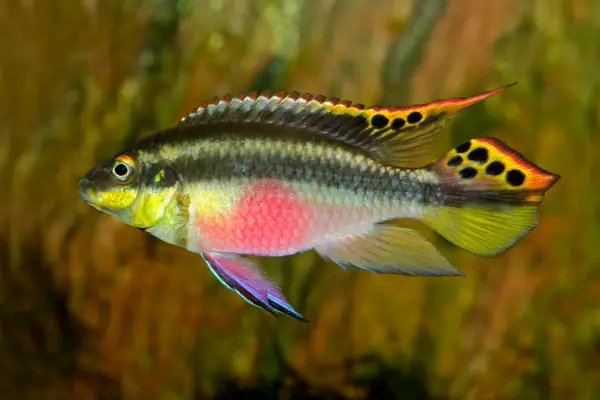
What if I Want to Save a Little?
Northfin products are premium and priced accordingly. Therefore, I recommend taking a close look at Omega One Super Color Cichlid Pellets. Their formula covers all of the right bases, netting you color enhancers, vitamins, and both animal and plant protein.
But if you have a fish tank full of carnivores, Fluval Bug Bites pellets are hard to beat, thanks to their primarily animal-based formula!
FAQs About Cichlid Food

How Much Food Should I Feed My Cichlids?
For smaller cichlids, know that their eye is roughly the size of their stomach, so offer food accordingly. Larger cichlids have larger appetites, so you’ll have to provide enough that their bellies visibly swell without overfeeding.
How Often Should I Feed My Cichlids?
Cichlids are fairly active fish and should be fed at least twice per day. Even as adults, smaller cichlids can be fed three times per day, while larger species with slower metabolisms should only be fed twice per day once fully grown.
Do Cichlids Prefer Flakes or Pellets?
Pellets are almost always better for cichlids. Flakes are messier and only suitable for smaller fish.
What Human Foods Can Cichlids Eat?
Cichlids can eat many human foods! If you have carnivorous fish, offer them seafood like white fish, salmon, and chopped shellfish. Small pieces of lean chicken are also acceptable but stay away from beef or pork, which are too fatty and unhealthy for cichlids.
Can Cichlids Eat Vegetables?
Absolutely! In fact, I’d say vegetables are essential for herbivorous types. Lightly boiled lettuce, spinach, and kale are all enjoyable. And for larger species, you can offer them whole peas or corn kernels that have been balanced briefly!
You May Also Like:

